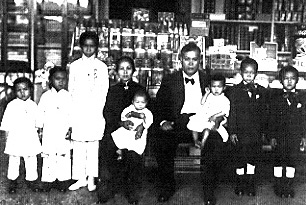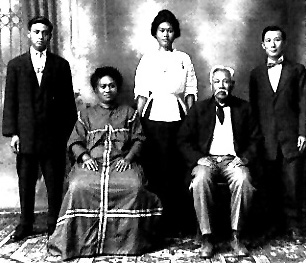


 The first Asians in
Hawai`i were the Chinese men who crewed merchant ships. Records from
the late 1700's show the original Chinese in Hawai`i owned stores and
businesses. The Chinese women mainly came to Hawai`i either to be
married
or already as wives to join their husbands. The earliest Chinese women
in
Hawai`i spent their time sewing work clothes for their husbands and some
made money as dressmakers.
The first Asians in
Hawai`i were the Chinese men who crewed merchant ships. Records from
the late 1700's show the original Chinese in Hawai`i owned stores and
businesses. The Chinese women mainly came to Hawai`i either to be
married
or already as wives to join their husbands. The earliest Chinese women
in
Hawai`i spent their time sewing work clothes for their husbands and some
made money as dressmakers.
 Some of the first sugar
mills were owned by Chinese. They brought technical skills in sugar
manufacturing with them from China. Many of these men married Hawaiian
women. By 1838, approximately 35 Chinese males resided in Hawai`i. In
1865, Commissioner of Immigration William Hillebrand brought 473 male
Chinese and 52 women (wives of these laborers) from China. There was
only one Chinese woman for every 17 Chinese men by 1884. By 1920, less
than a third of the Chinese men had Chinese wives living in the islands.
Many of the Chinese who became naturalized citizens married Hawaiian
women.
Some of the first sugar
mills were owned by Chinese. They brought technical skills in sugar
manufacturing with them from China. Many of these men married Hawaiian
women. By 1838, approximately 35 Chinese males resided in Hawai`i. In
1865, Commissioner of Immigration William Hillebrand brought 473 male
Chinese and 52 women (wives of these laborers) from China. There was
only one Chinese woman for every 17 Chinese men by 1884. By 1920, less
than a third of the Chinese men had Chinese wives living in the islands.
Many of the Chinese who became naturalized citizens married Hawaiian
women.
 New diseases brought by
all the new peoples coming to Hawai`i devastated the native Hawaiian
population. In 1850 Hawai`i passed the "Act of Government of Masters and
Slaves" allowing the Plantation owners to bring foreign laborers into
Hawai`i for contract labor. The first ship, carrying 200 Chinese
workers, came to Hawai`i in 1852. There were no laws in Hawai`i against
women working so many of the laborers were women. Between the years of
1852 and 1929 over 45,000 Chinese came to Hawai`i.
New diseases brought by
all the new peoples coming to Hawai`i devastated the native Hawaiian
population. In 1850 Hawai`i passed the "Act of Government of Masters and
Slaves" allowing the Plantation owners to bring foreign laborers into
Hawai`i for contract labor. The first ship, carrying 200 Chinese
workers, came to Hawai`i in 1852. There were no laws in Hawai`i against
women working so many of the laborers were women. Between the years of
1852 and 1929 over 45,000 Chinese came to Hawai`i.
